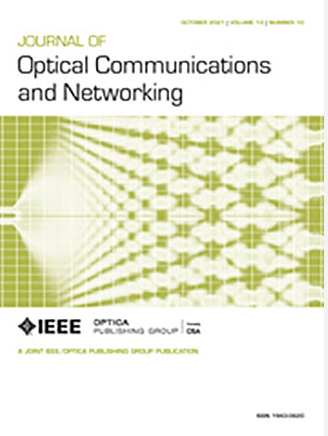技术融合正在重塑6G接入网架构,但我们的基础设施准备好应对了吗?(邀请)
IF 4.3
2区 计算机科学
Q1 COMPUTER SCIENCE, HARDWARE & ARCHITECTURE
引用次数: 0
摘要
6G的目标是进一步提高人与人之间通信的体验质量,同时通过集成各种技术、服务和应用来改变工业4.0的格局。为了实现这一目标,有线和无线技术之间出现了快速融合的步骤,以实现统一的运输平台,这促使了架构的修改。智能现在分布在更靠近终端用户的地方,远端节点变得至关重要。然而,这些节点必须平衡性能和运营商的负担能力。此外,有线和无线技术的融合必须考虑到最后一英里光纤的稀缺性。在这项工作中,我们为光纤稀缺框架下的并行、解耦光纤基础设施与单一无源PtMP连接方案的争论做出了贡献,这些方案适用于具有多gb /s线路速率的住宅用户,而小型小区则利用毫米波技术与${\gt}{100}\;{\rm MHz}$射频带宽。我们的分析是基于运营商提供的有关实际部署中的实际约束和限制的信息,并且是基于真实的地理空间数据。我们得出的结论是,当采用低成本的灰色接口时,光纤利用率在两种替代方案下都变得过高,并且只有在引入彩色接口和WDM时,部署才在光纤利用率方面变得可行。此外,这项工作有助于讨论下一代PON技术在不增加光纤使用的情况下适应不同容量需求的有效性。最近发布的25G和50G TDM pon正在努力满足当前光纤部署框架内的连接需求,因为使用高层分裂(F1)的小型蜂窝和住宅用户使用多gb /s的线路速率。除此之外,当采用低层分割的小型蜂窝与多gb /s线速率的住宅用户一起部署时,利用PtMP树和支持400G总容量的技术的共享方案似乎是防止光纤基础设施耗尽的下一个障碍。最后,我们根据替代400G解决方案的资源利用率基准报告了我们的发现。本文章由计算机程序翻译,如有差异,请以英文原文为准。
Technology convergence is reshaping the 6G access network architecture, but are our infrastructures ready to cope? [Invited]
The goal of 6G is to further advance the quality of experience in human–human communications while it transforms the I4.0 landscape by integrating a diverse set of technologies, services, and applications. To achieve this goal, there are rapid convergence steps between wireline and wireless technologies toward a unified transportation platform, something that prompts architectural modifications. Intelligence is now distributed closer to end-users, with far-edge nodes becoming essential. However, these nodes must balance performance and affordability for operators. Moreover, the converged wireline and wireless technologies must consider the scarcity of fiber in the last mile. In this work, we contribute to the debate of parallel, decoupled fiber infrastructures versus a single passive PtMP connectivity scheme under the framework of fiber scarcity and for residential users with multi-Gb/s line rates, while small cells exploit mmWave technology with ${\gt}{100}\;{\rm MHz}$ RF bandwidth. Our analysis is based on the information supplied by operators regarding the practical constraints and limitations arising from real-life deployments, and it is based on realistic geospatial data. We conclude that fiber utilization becomes prohibitively high under both alternatives when low-cost, gray interfaces are employed, and the deployments become viable in terms of fiber utilization only when colored interfaces and WDM are introduced. Furthermore, this work contributes to the discussion on the efficacy of next-generation PON technology in accommodating varied capacity requirements without increasing fiber use. The recently announced 25G and 50G TDM PONs are struggling to satisfy connectivity demands within the current fiber deployment frameworks when small cells utilizing high-layer splits (F1) and residential users are served by multi-Gb/s line rates. Beyond this point, when small cells employing low-layer splits are deployed alongside multi-Gb/s line-rate residential users, a shared scheme utilizing PtMP trees and technologies supporting a total capacity of 400G seems to be the next barrier to reach to prevent the depletion of fiber infrastructures. At the end, we report our findings based on the benchmark of alternative 400G solutions against their resource utilization.
求助全文
通过发布文献求助,成功后即可免费获取论文全文。
去求助
来源期刊
CiteScore
9.40
自引率
16.00%
发文量
104
审稿时长
4 months
期刊介绍:
The scope of the Journal includes advances in the state-of-the-art of optical networking science, technology, and engineering. Both theoretical contributions (including new techniques, concepts, analyses, and economic studies) and practical contributions (including optical networking experiments, prototypes, and new applications) are encouraged. Subareas of interest include the architecture and design of optical networks, optical network survivability and security, software-defined optical networking, elastic optical networks, data and control plane advances, network management related innovation, and optical access networks. Enabling technologies and their applications are suitable topics only if the results are shown to directly impact optical networking beyond simple point-to-point networks.

 求助内容:
求助内容: 应助结果提醒方式:
应助结果提醒方式:


